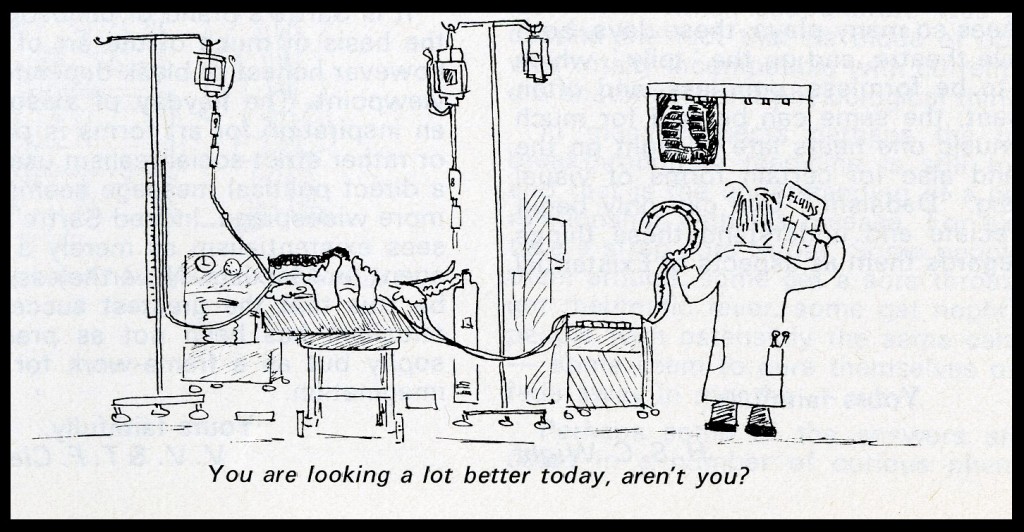Joyce-Elena Ní Ghiobúin graduated from Trinity College, University of Dublin, with an MPhil in Reconciliation Studies in 2012. Since then she has been researching denominational aspects of British-Irish nursing history in the late 19th and 20th centuries and may be contacted at nighiobj@tcd.ie.
Writing to a friend in 1960, Dr Cicely Saunders commented on the increased crisscross of letters, “We’re going to need an archivist someday to make sense of this!” [1]
That anticipation crossed my mind when first confronted with a selection of files at the King’s College London Archives. I was amazed by Dr Saunders’ eye for detail and her foresight in creating records of so many encounters – she must have had future generations in mind!
The documents I consulted were filed thematically, thereby often dating back to a specific period in her life. Yet two core interests spanned the years from her first involvement in hospice care in the late 1940s up until her death in 2005: her restless initiative in expanding her own medical awareness, and a preoccupation with the spiritual aspect in care provision.
These are encapsulated in the words of a patient who served as the founding narrative of the hospice: “I only want what is in your mind and in your heart”. [2] Saunders invested herself in caring for patients in the 1940s, saying “we had so often nothing to offer but ourselves”. [3] Because of this, her mentor Dr Barrett urged her to read medicine if she wanted to change end-of-life care because, in his words, “It’s the doctors who desert the dying”. [4]

The material at King’s College London Archives provides a trail of primary documents beginning from the point at which Cicely Saunders decided to follow that advice. Among the papers placed in my hands as a researcher were the drafts of her M.D. thesis examining pain control among terminal cancer patients, which was a novel direction for research in the mid-1950’s as most doctors focused on curative care problems. The material includes her handwritten calculations and brainstorming exercises, interspersed with letters from her supervisor on how she might rearrange her thesis chapters to best effect. Two of Saunders’ letters are addressed to a professor of veterinary science who had developed tranquilizers for rhinoceros in Uganda using a mixture of morphine derivatives: she wrote to him in 1964 for further insight into analgesics and their tested effects. Still more files contain cuttings from medical journals on the most up-to-date pain control debates [Fig. 1]. Such early investigative thrusts – St Christopher’s would not open until 1967 – attest to Saunders’ resolve to base future hospice work on the best medical and ethical practice. She later affirmed that St Christopher’s was neither the first nor “the model” hospice, but an example of how up-to-date research might be conducted alongside intuitive patient attention in the same care-giving space.


What is especially interesting in Saunders’ 1960s poetry collections is her preference for Christian poetry – including, for example, an amusing song from 5-year-old “Lucy” beginning with the line, “When the Baby was borned, Joseph said to Mary …” Her 1983 publication replaces most of these poems with choices that are more wide-ranging both denominationally and geographically, in itself reflective of Saunders’ personal journey in later years to reach beyond her “home” in the Anglican Evangelical tradition. Nevertheless, the thematic framework of Beyond all Pain’s chapters (e.g. ‘Suffering’, ‘Dying’ and lastly ‘Resurrection’) preserves a Judeo-Christian framework of meaning. For Saunders, “spirituality” was “much wider than religious practice. It is the search for meaning, the look at one’s own most important values, the feeling of looking beyond yourself and of somehow belonging to something more than you are”. [5] All researchers looking back on Saunders’ collections, regardless of their individual evaluation of the importance of the spiritual, face the fact that nearly a third of her publications, if not more, were concerned with the dynamics of “spirituality” in end-of-life care.

2017 marks the fiftieth anniversary of the establishment of St Christopher’s Hospice. This commemorative year, together with the research it promotes, is itself a season of transition, appreciation and learning, like that of Saunders’ in the years leading up to the establishment of St Christopher’s in 1967. As she herself remarked on Desert Island Discs in 1994, the modern hospice is not about “bricks and mortar” but rather about the attitudes, skills and ideas that are “spreading widely” because of St Christopher’s Hospice, enabling many patients to count their last days as their fullest. Her dedication in promoting pain control and personal concern helped to forge a comprehensive approach to medical care, a lifetime’s actualisation that is thankfully well-documented and well-looked-after. For the researcher of Hospice History as much as for the patient in its care, it might well be said, to quote a favourite anthology of Saunders’, “All in the end is harvest”.[6]
References:
[1] David Clark, “Making Sense of Cicely Saunders”. International Symposium on Cicely Saunders, Hospital San Juan de Dios, Pamplona, October 17th 2015.
[2] David Tasma, quoted in Shirley du Boulay, Cicely Saunders: The Founder of the Modern Hospice Movement (London: Hodder and Stoughton, 1987), 56.
[3] Saunders, Watch with Me (Sheffield: Mortal Press, 2003), 41.
[4] Norman Barrett, quoted in du Boulay, Cicely Saunders, 63.
[5] Saunders in conversation. “Elements and Models of Palliative Care: A Conversation with Dr Cicely Saunders’’, Youtube. [Accessed 15 May 2017].
[6] This line is from Edith Sitwell’s poem Eurydice and was adopted as the title of an anthology by the same name edited by Agnes Whitaker. All in the End is Harvest: An Anthology for those who Grieve (London: Darton, Longman & Todd, 1984) was a valued volume in Dr Saunders’ personal collection.